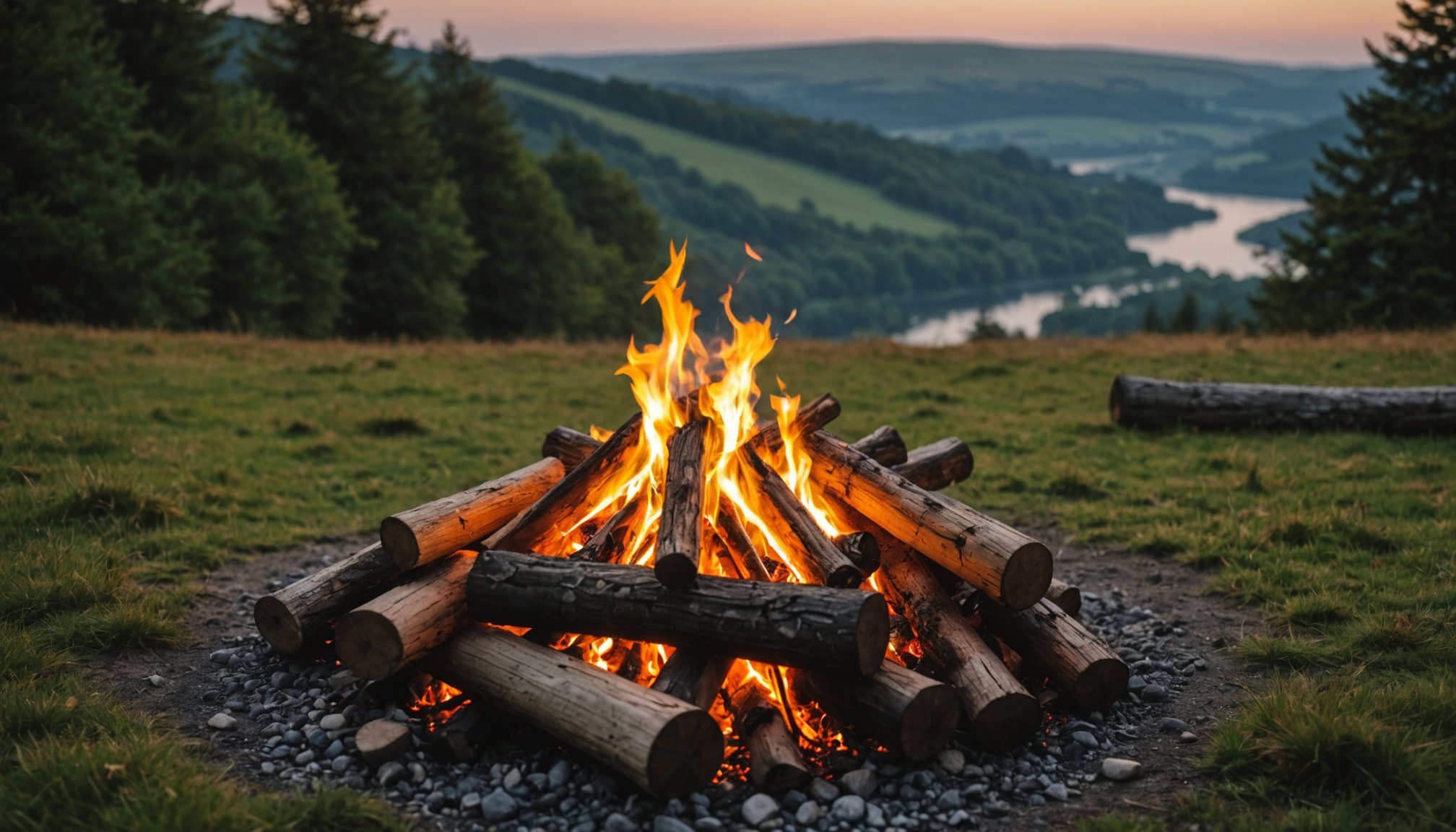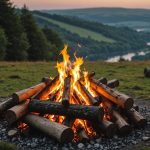Ultimate Guide to a Safe and Green Campfire Experience in the UK
Planning Your Camping Trip: The Foundation of Safety and Enjoyment
Before you embark on your camping adventure in the UK, it’s crucial to plan thoroughly. This involves more than just packing your gear and choosing a camping spot; it’s about ensuring you’re prepared for every eventuality.
Research Your Campsite
Start by researching your chosen campsite. Understand the terrain, weather conditions, and any potential hazards such as flood-prone areas or dead trees that could fall. For beginners, starting at established campsites is a great way to build confidence and learn essential skills in a controlled environment[2].
Also read : Ultimate guide to camping with toddlers in the uk: key tips for a successful adventure!
Check Permits and Restrictions
Always check if there are any permits or restrictions required for the area you plan to camp in. National parks and protected areas often have specific rules to ensure the preservation of the environment.
Share Your Itinerary
Inform a trusted friend or family member about your itinerary, including your expected return date. This practice not only reassures loved ones but also ensures that help can reach you if needed[2].
Also to see : Ultimate guide to sustainable camping: eco-friendly tips for a conscious adventure in the uk
Choosing the Right Gear: Safety and Comfort
The right gear can make a significant difference in your camping experience, ensuring both safety and comfort.
Tent and Sleeping Bag
Invest in a sturdy, weather-resistant tent that matches the season and environment of your trip. A proper sleeping bag is essential to protect you from the cold. Look for sleeping bags with a suitable temperature rating for the time of year you’re camping[5].
Essential Safety Gear
Carry essential safety gear such as a whistle, multitool, first-aid kit, and a headlamp. A satellite communicator or GPS device with an SOS feature can be a lifesaver in remote areas where cell service is nonexistent[2].
Setting Up Your Campsite: Safety Protocols
Your campsite setup is crucial for ensuring safety and minimizing environmental impact.
Choose a Safe Location
Select a campsite on level ground, away from flood-prone areas or dead trees. Maintain a safe distance from water sources to avoid flash floods or unwanted wildlife visits. Keep your cooking area separate from your sleeping area to reduce the risk of attracting animals[5].
Campfire Safety
Campfires are a central part of the camping experience, but they need to be managed carefully to avoid starting wildfires. Here are some key tips:
- Use Eco-Friendly Fire Pits: Consider using smokeless fire pits which provide warmth with minimal smoke and are easier to clean. These pits ensure complete combustion of the fuel, reducing the environmental impact[1].
- Seasoned Wood: Use kiln-dried or seasoned wood that has had time to dry out over six or more months. Green or wet wood burns more slowly and may produce smoke even in smokeless fire pits[1].
- Proper Extinguishing: Properly extinguish campfires before leaving them unattended. Make sure the fire is completely out by dousing it with water and stirring the ashes to ensure everything is extinguished[5].
Minimizing Environmental Impact: Leave No Trace Principles
Camping in the wild comes with a responsibility to leave the environment as you found it.
Respect the Environment
Follow the “Leave No Trace” principles:
- Plan Ahead and Prepare: Know the regulations and special concerns for the area you’ll visit.
- Travel and Camp on Durable Surfaces: Stay on designated trails and campsites to avoid damaging vegetation.
- Dispose of Waste Properly: Pack out all trash and dispose of human waste in a responsible manner.
- Leave What You Find: Do not disturb natural or cultural resources.
- Minimize Campfire Impacts: Use established fire rings, keep fires small, and fully extinguish them before leaving[5].
Staying Safe in the Great Outdoors
Safety is paramount when camping in the wild. Here are some tips to ensure you stay safe:
Be Weather-Wise
Check the forecast before you leave and prepare for unexpected shifts in weather. Pack rain gear, sun protection, and layers to adapt to different weather scenarios. Familiarize yourself with signs of hypothermia, dehydration, and heatstroke so you can act quickly if needed[5].
Emergency Communication
Carry a reliable means of communication such as a satellite phone, personal locator beacon (PLB), or GPS device with SOS capabilities. Practice signaling techniques, such as using mirrors or whistles, to attract attention if needed[5].
Basic Survival Skills
Being equipped with basic survival skills can give you confidence and security. Learn how to build a fire, filter and purify water, and navigate using a map and compass. Basic first-aid knowledge is also crucial for treating cuts, burns, or insect bites[5].
Wild Camping: Additional Considerations
For those venturing into wild camping, there are additional considerations to keep in mind.
Start with Established Campsites
For beginners, starting at established campsites is a great way to build confidence before transitioning to solo wild camping. This approach allows you to learn essential skills in a controlled environment[2].
Inform Others
Always let someone know your camping location and your itinerary. Check in with a trusted contact multiple times a day. If you find yourself without signal, have a predetermined wait-time before they should raise the alarm[2].
Bring a Dog
Having a dog can act as a deterrent to potential threats and provide an additional layer of security and companionship. Even small dogs can alert you to nearby activity[2].
Managing Campfires in High-Risk Areas
In areas prone to wildfires, managing campfires is critical.
Use Technology
Technologies like early detection methods can help mitigate the risk of wildfires. For example, the National Trust has been trialling early detection methods on Marsden Moor in West Yorkshire to protect rare moorland habitats[3].
Follow Local Guidelines
Be aware of local guidelines and restrictions on campfires. In high-risk areas, campfires may be completely prohibited. Always follow the advice of local authorities and park rangers.
Practical Tips for a Safe Campfire Experience
Here are some practical tips to ensure your campfire experience is both safe and enjoyable:
Best Practices for Campfires
- Use Smokeless Fire Pits: These pits ensure complete combustion of the fuel, reducing smoke and environmental impact[1].
- Keep a Safe Distance: Ensure the fire pit is at a safe distance from combustible surfaces. Use a heat shield or fire pit mat if necessary[1].
- Monitor Wind Conditions: Be aware of wind conditions as they can affect the distribution of heat and the visibility of smoke[1].
Gear Checklist
Here is a detailed checklist of gear you might need for a safe and green campfire experience:
- Tent and Sleeping Bag
- Sturdy, weather-resistant tent
- Proper sleeping bag with suitable temperature rating
- Safety Gear
- Whistle
- Multitool
- First-aid kit
- Headlamp
- Satellite communicator or GPS device with SOS feature
- Campfire Gear
- Smokeless fire pit
- Kiln-dried or seasoned wood
- Firewood pellets (if applicable)
- Ash pan and carrying case
- Emergency Supplies
- Water filter or purification tablets
- Emergency beacon or satellite phone
- Maps and compass
- Basic survival tools (e.g., knife, rope)
Table: Comparing Smokeless Fire Pits
Here is a comparative table of some of the best smokeless fire pits available, highlighting their key features:
| Model | Dimensions | Weight | Fuel | Carrying Case/Cover | Ash Pan |
|---|---|---|---|---|---|
| Tiki Fire Pit | 24.8 x 24.8 x 18.8 in. | 45 lbs. | Wood, wood pellets | Yes | Yes |
| Bonfire Pit | 27.5 x 27.5 x 16 in. | 38 lbs. | Wood | Yes | Yes |
| Solo Stove Pit | 19 x 19 x 15 in. | 20 lbs. | Wood | Yes | Yes |
Quotes and Insights
- “The real dangers often stem from a lack of preparation and awareness rather than external threats,” notes an experienced camper. This underscores the importance of thorough planning and being informed about the environment you’re camping in[2].
- “Having a dog can act as a deterrent to potential threats. Even small dogs can alert you to nearby activity,” says another camper, highlighting the additional layer of security a dog can provide[2].
- “Wildfires pose a life-threatening danger to the firefighters deployed to tackle the blazes,” warns Carsten Brinkschulte, CEO of Dryad Networks, emphasizing the critical need for careful campfire management[3].
Camping in the UK can be a wonderful experience, offering a chance to connect with nature and enjoy the great outdoors. However, it’s crucial to approach this adventure with the right mindset, gear, and knowledge to ensure both safety and minimal environmental impact.
By following the tips outlined in this guide, you can make sure your camping trip is not only enjoyable but also safe and eco-friendly. Remember to plan ahead, choose the right gear, respect the environment, and always prioritize safety. With these principles in mind, you’ll be well on your way to creating memorable and responsible camping experiences.











